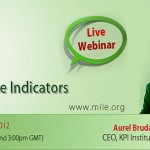A journey: excellence in delivering webinars

If your intention of delivering a successful webinar is followed by questions such as: “When should I drop promotional emails?”, “Should I be worried if half of the registrants didn’t actually attend the webinar?”, “What kind of engagement tools should I use?,” then you should know that the answers are more simple than expected: Thursday. No. Polls. There are some guidelines to support a much greater return of the efforts.
The reasons why webinars are so often employed by businesses around the world are extremely varied, from presentation of products, services and events, to potential sales leads generation. On the other side, individuals plan to attend webinars in order to obtain more information, to learn, and to understand issues in depth. Regardless of the area or industry you are part of, and whatever your reason is for delivering a webinar, let’s discover actions that can increase attendance, engage your audience, and get business results on your webinar efforts.
A recommended strategy is to follow 3 different approaches: before, during and after the event, and sketch a series of guidelines for creating, promoting and delivering successful webinars. Following these guidelines, we are going to analyze each stage, and also create a complete journey as we identify areas where improvements can be brought.
Along this journey, we are going to discover insight from ON24 Webinar Benchmarks Report, the 2014 Edition, which comprises statistics from 7,055+ webcasts conducted in 500+ organizations. ON24 is the global leader in cloud-based solutions for webcasting and virtual communications.
It is important to prove an incorporated approach of your work, taking into consideration the audience’s perspective from registration, delivery preparation, to follow-up actions after the webinar. In this respect, we will analyze these aspects for webinars with a one-hour long audio- and slide-based presentations. Now let’s have a look at them one by one for an in-depth understanding.
Before the webinar
Don’t avoid making plans for the pre-webinar stage! Preparation in advance implies more than just creating an interesting topic for the presentation and a catchy description for it. This phase marks aspects such as: registration and promotion, details of the landing page, target audience and creating the premises for the registrant to attendee conversion from the next phase.
The Webinar Benchmarks Report reveals a set of comparisons on registration and promotion that represent best practices for webinars that are one hour long audio- and slide-based presentations:
- 58% people register the week of live webinar;
- best day for registrations is Thursday, when 24% of the people access the registration landing page;
- best days to send promotional emails are Tuesday, Wednesday and Thursday;
- best days for webinar delivery are Tuesday, Wednesday and Thursday; that’s when attendance rates get up to 27%.
In order to measure the performance of this phase, you can use the following KPIs:
- % Registration rate;
Number of people who register for the webinar out of the total number of people exposed to the registration page.
- # Time spent to promote webinar;
Measures the average time dedicated to promoting a webinar.
- $ Promotion costs/webinar;
Represents the average cost to promote one webinar.
In conclusion, the middle of the week is ideal to promote and deliver webinars, and you should take into consideration the effectiveness of your registration landing page, the quality of the messages and the audience you are targeting.
During the webinar
A successful webinar is not about having a spectacular number of attendees, but about keeping the audience engaged and satisfied. This phase is crucial in terms of the value added and the takeaways of the audience. Their satisfaction with the information provided will be reflected mainly through the time they spend on viewing the presentation. The Webinar Benchmarks Report exposes the following benchmarks:
- Average viewing time is 56 minutes;
- The registrant-to-attendee conversion ratio is, on average, 42,9%;
- 85% of webinars use, as an interactivity tool, the live Q&A session;
- 5% of the audience is actually asking questions during the webinar:
- 21% of the audience responds to polls.
These findings show that the behavior of the attendees reflects engagement for almost the entire presentation, as an exception to the rule sustaining the short attention span rate of people. Another paradox is represented by the Q&A session, as it is used on a large scale on webinars design and still, only 5% of the audience is actually interested in being actively involved and addressing questions during that allocated period of time. It would be preferable to take advantage of another audience engagement tool that has a high success rate, such as the poll.
In order to measure the performance of this phase, you can use the following KPIs:
- # Attendees;
Measures the average number of attendees per webinar.
- % Registrants to attendees ratio;
Measures the percentage of people attending the webinar, out of the registrants.
- # Viewing time;
Measures the average time that attendees spend viewing the live webinar.
- % Drop rate after 50 minutes;
Measures the percentage of attendees who did not wait until the end of the webinar.
After the webinar
If you thought that the hardest part has passed, you are wrong! It turns out that the post-webinar phase defines the ability to create long term relationships through the follow-up with attendees and analysis of areas where you could’ve done better. On the other side, attendees’ satisfaction will be reflected through their intentions of attending another webinar, recommending the webinar to someone else, or even being interested in other products or services provided by you.
In order to measure the performance of this phase, you can use the following KPIs:
- # Repeated attendees;
Measures the number of attendees that have attended at least two webinars.
- % Net promoters score;
Measures the percentage of attendees that would recommend the webinar to other people.
- # Upselling based on webinar;
Measures the number of upselling transactions realized as a result of the webinar.
There are a variety of best practices that can improve webinars’ effectiveness and this article illustrates a three- phase journey with important aspects to take into consideration on the long run. Webinars allow companies to expand their reach and deliver cogent experiences. This aspect is what strengthens and increases a company’s expectations from the one hour presentation. Allow yourself to be a beginner, but remember how important it is to maximize the impact of your webinar, step by step.
References:
- ON24 (2014), ON24 Webinar Benchmarks Report
- ReadyTalk (2015), Best practices for Conducting Engaging Webinars
Image Source:

Tags: Education and Training performance, Organizational Strategy, webinar





